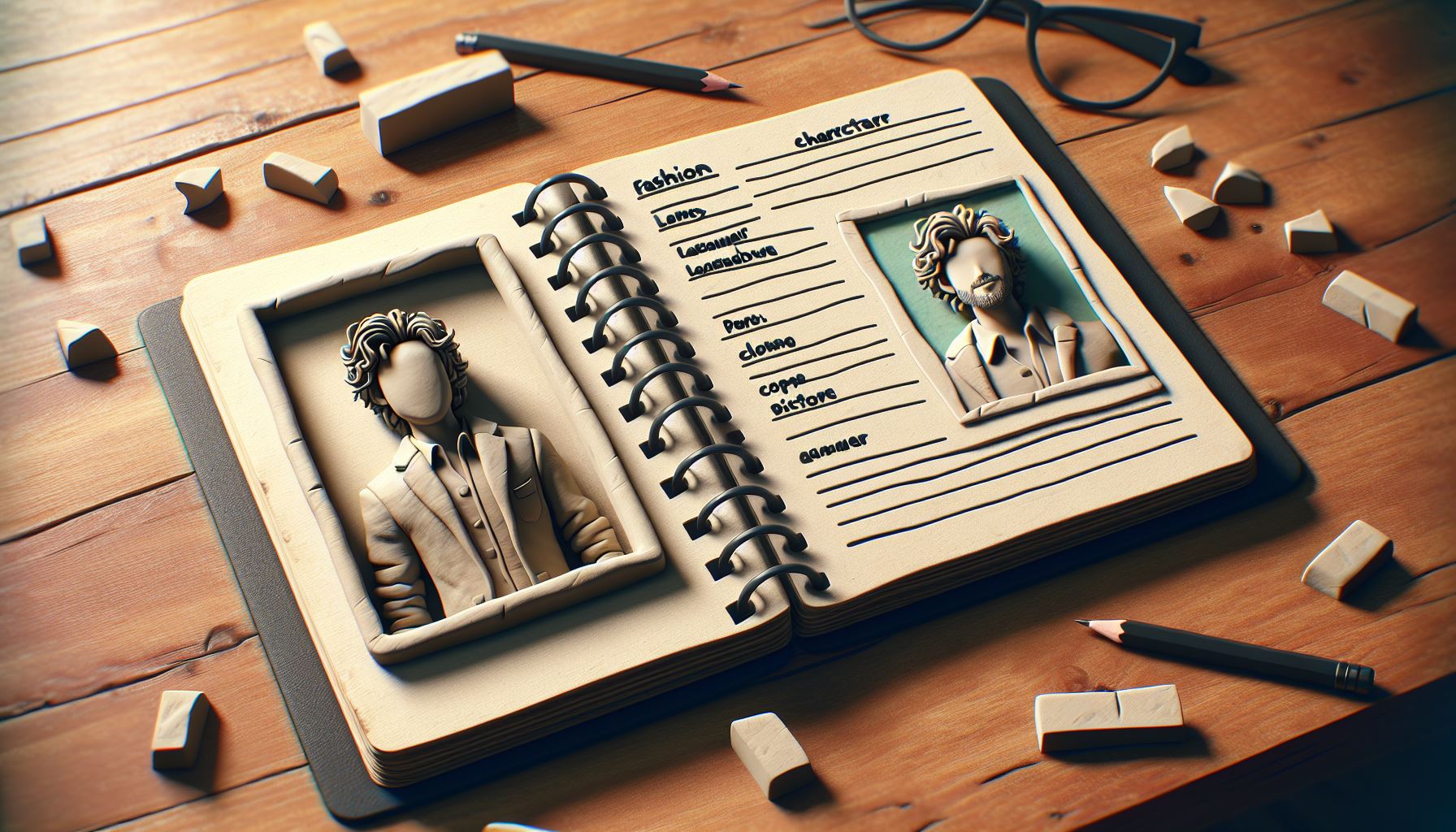We will all agree if I say that characters are an essential element in any fiction piece. A story is “something” that happens to “someone”. What drives us through the pages of a novel is getting into the main character’s skin, feeling what they feel, and thinking about how that subplot will affect their lives. Simply as that, complex as that.
This is why building character profiles is crucial; they help us create better stories. However, developing characters from scratch can be overwhelming. You may be wondering: Where do I start? Are my characters compelling? How can I make the reader like them? How do I write characters that are different from me?
Don’t worry. I’ve created this post to guide you through that process. Let’s start from the beginning…
What is a character profile for?
As writers, most of us create our characters by trying to make them resemble real people. But no matter how hard we try or how well we do our job, a character will never be a real person. It is a representation, a pretense.
Through this representation, readers enter your story and feel they are experiencing it in the first person, getting into the shoes of your characters. As a writer, you should construct the plot and characters to make this journey memorable.
We use the character profile sheets to fill out all the information needed to build well-rounded characters. Because flat characters lead to flat stories, while deep characters lead to deep novels.
🎯 Pro Tip: If you are anything like me, you may enjoy having your writing projects well organized. Try Story Planner to create your character profiles and link them to your scene cards.
How much information does a character profile need?
If you had asked me this question twenty years ago, when I was starting to write my first novels, I would have answered that you need to specify as much information as possible, especially about the main characters.
Google it, and you will find thousands of different proposals to create your character profiles. Many of them are very long questionnaires where you have to meditate on a multitude of aspects of the lives of your characters. Sounds good, right? If you know your characters well, you will write better stories. Don’t you?
Over the years, I have realized that is not necessarily true. All those hours I spent filling out questions like “What is their favorite color”? “What is their favorite time of day”? “What was their favorite doll’s name when they were a child”? Those were hours I could have spent writing my actual novel. I was not building important aspects of my characters. I was distracting myself from what was important in the story. But hey, aren’t we writers the kings and queens of procrastination? I bet I am.
And yes, I have heard about Hemingway’s Iceberg Principle. Hemingway argues that any information you have, you can eliminate it, and it only strengthens your iceberg. But if you omit something because you do not know it, then there is a hole in the story.
However, do you really need to create a whole iceberg for each of your characters? No. You do not need to know every single detail of your character’s life, not even your protagonist’s. Unless it is relevant to the story, you do not have to create a profile in which you specify what day of the week they do the laundry, or what brand of shampoo they use.
🎯 Pro Tip: Pick Your Battles Wisely
Choose well the details of your character to develop. Decide which aspects of your character to showcase in your story thoughtfully. If you do this right, the readers will feel an entire iceberg, even if there is not.If your character is an expert in martial arts, that’s where you should put your effort. Research martial arts and use that information to show a part of your acquired knowledge.You probably do not need to become a black belt to write about your character either. Sometimes, it is enough for you to do some good research and then find a beta reader who is actually a black-belt martial arts expert. Their feedback will help you correct any errors or omissions.
How to create the perfect character profile?
Therefore, you do not need to know everything about your characters. That is clear, right? Let us see what you do need to know.
🎯 Pro Tip: Most of the topics we will explore below are interconnected rather than isolated entities. You can even feed off other parts of the story to build better characters, such as the story’s theme.
1. Character’s Name
It may sound silly, but it is not as trivial a topic as it seems. The name of a character can say a lot about the time in which they live, their social status, and their family. And not just the name. Do they have a nickname? Who chose that nickname? When?
You can use a name generator to get some character name ideas, but you should also consider the keys to write the names of your characters.
🎓 Learn more: How to Come Up With Great Character Names Ideas
2. Role in the Story
There are many different types of characters in a novel or a movie, and this classification is not solely based on their screen time. They can be main characters, supporting characters, or secondary characters, but each of them fulfills a specific role in the story.
Knowing whether a character is an antagonist, impact character, or love interest will help you better establish their connection to the story. You can also use archetype characters as a starting point and then modify them to best suit your plot.
3. Age and Date of Birth
Another important aspect is the age of the character. You should know it specifically. Write down “The character is forty-seven years old” instead of saying they are in their forties.
If the story takes place in several periods, then write down the date of birth as a reference to calculate the age at different moments. This information will help you avoid inconsistencies, even if you do not use it within the story.
4. Motivation and Goal
Motivation and goal can also be called internal and external goals respectively. Sometimes, the internal and external goals may coincide, but it is not the most common or recommended. The character is much more compelling when it has distinct motivations and goals.
The external goal is the evident objective that the character will have in the plot. What do they need to achieve? Do they need to get an important document? Do they have to solve a murder? Or do they need to catch something to avoid dying of starvation, as in the novel “The Old Man and the Sea”?
Motivation, on the other hand, is what moves the character forward. What do they really want inside? Do they want to prove to their parents that they are worthy? Do they want to find true love? Or do they want to demonstrate that they are not yet so old that they have nothing to offer, again, as in “The Old Man and the Sea”?
Of course, a character can have multiple motivations. Sometimes, their motivations can conflict with the objective, which brings us to the next point.


5. Dilemma
This element is not always present in the characters, and it is definitely not necessary to develop it for the less important characters in the plot. But it is interesting for the main characters because it will give them a new dimension and add another conflict to the story: The inner conflict.
Let me explain it to you with an easy example: Our protagonist is an executive who wants to get a promotion. His motivation is to get her father’s approval. However, in the battle for promotion, the executive falls in love with his rival. Now, the character has to decide whether to continue his career toward success or give up everything for love. Should he be vulnerable in the eyes of his father? Or should he crush his opponent and lose his true love?
As you can see, the inner conflict directly concerns the character’s morals, their value system, and even their misbeliefs. It is more interesting when we confront all these elements with the character’s flaws and the story’s themes. This is when we really start to build something.
6. Adherence to the Plot
Another essential element to consider is the character’s adherence to the plot: The reasons they have to keep fighting for a goal. Although these motivations may be clear at the beginning of the story, as obstacles appear, there has to be a reason for the character not to give up. And it has to be a compelling reason. The good news is that looking for that reason will also lead us to find their true motivation.
Let me give you an example —It is somehow extreme, but I think it will help make my point: We have a woman whose goal is to catch the biggest fish in the lake to win a contest. But, suddenly, some participants start disappearing because a strange creature is attacking them. In a normal situation, the character might give up. The prize is attractive, but not enough to put her life at risk. However, if winning that prize were a case of life or death for her, if her motivation was to get the money for a delicate operation for her sick daughter, we would believe that she would not give up the goal. That is adherence.
7. Physical Description
What do your characters look like? What clothes do they wear? What physical characteristics would you highlight? As always, try to find data that is important to the story. Knowing that they have blonde hair or green eyes may not be relevant. But the fact that the protagonist has long hair and she usually uses the strands that stick out to hide her face when she feels embarrassed… Yes, that is relevant.
🎓 Learn more: How to Write Character Descriptions —Guide and Examples
8. Psychological Description
This section may seem easy to fill out, but it is not. If someone asks us what our characters are like psychologically, our first instinct may be to explain things like they are shy, happy, or grumpy. And that is ok. This data can help a little, but it is vague. We need to get deeper. We need stronger feelings. This is where the three pillars of a character’s personality come into play: flaws, disadvantages, and particularities.
9. Biography
Now is the time to talk about your character’s life before the plot begins, and some aspects of their life, such as studies, profession, friends, family, relationships with other characters… But, for your own sake, do not dawdle too much in the dull parts and get straight to what is relevant to the story: Those moments that changed your character forever. The moments that made them who they are.
Does your character have a deep misbelief? What happened in their past to make them believe such a thing? Is their peculiarity taking devices apart to see how they work? Why and when did they start?
Another aspect of the biography you should write down here is the character’s situation before the story begins, before the inciting incident. What is their world like, their daily life, their ordinary life?
🎯 Pro Tip: Each character is the protagonist of their own story. You can use this thought to understand your characters. Imagine what they would have become and where they would have been if the main plot had not taken over their lives.
10. Character Arc
The character arc is the evolution of the character in the story. What do they learn? How does the plot affect their personality? How do their beliefs evolve? Does their status quo change?
Sometimes, writing a character arc can be the same as planning a subplot for your story, especially when it involves a side character.
🎓 Learn more: What Are Flat Characters and How to Use Them in a Story
And those are the points that I consider most important to start working on my characters. What about you? Do you have any other items that you can’t stop analyzing to get to know your cast?
